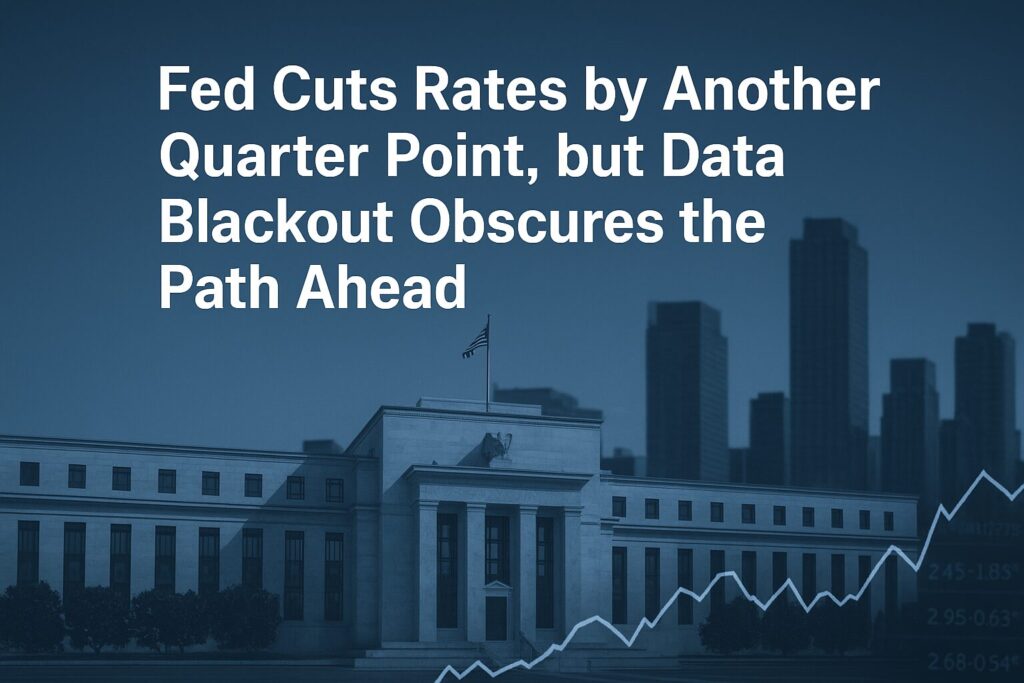Major Takeaways
The Fed’s decision marks the second consecutive rate cut this quarter, signaling continued caution about economic slowdown.
A temporary blackout in key federal data releases has clouded the outlook for inflation, employment, and consumer spending trends.
Markets remain divided on whether additional cuts are coming, as Chair Powell emphasized “data dependency” amid limited visibility.
Fed Cuts Rates by Another Quarter Point, but Data Blackout Obscures the Path Ahead
The Federal Reserve lowered its benchmark interest rate by a quarter percentage point this week, marking a continued effort to support the U.S. economy as inflation eases and the job market shows early signs of slowing. The decision highlights the central bank’s balancing act between keeping prices stable and preventing the economy from slipping into a deeper slowdown.
A Cautious Adjustment by the Fed
The Federal Open Market Committee voted to reduce the target range for the federal funds rate to 4.00 to 4.25 percent. It is the first rate cut since the end of last year and the second in a broader shift toward easing monetary policy. Federal Reserve officials noted that risks to employment have increased as job creation has slowed and the unemployment rate has inched higher.
Inflation, while down from the highs of the past two years, continues to hover around three percent. The Fed’s official target remains at two percent, but policymakers now appear more willing to tolerate slightly higher inflation in exchange for stabilizing the labor market.
In its statement, the Fed emphasized that future decisions will depend heavily on new data, noting that it expects at least two more quarter-point cuts before the end of the year if conditions warrant. However, analysts say the outlook is clouded by uncertainty following a temporary blackout in the release of several key government data reports. That lack of information has left markets guessing about the true pace of inflation, job growth, and consumer spending.
Why It Matters for City Residents
For people living in major urban centers, rate cuts ripple through everyday life in a variety of ways. Lower short-term borrowing costs affect credit cards, auto loans, and business lines of credit first. Over time, they can also influence mortgage rates and housing affordability, though the impact is usually gradual.
Homeowners and Renters: Mortgage rates are largely tied to long-term Treasury yields, which did not fall sharply after the Fed’s announcement. As a result, the immediate relief for potential homebuyers may be limited. However, sustained rate cuts over the coming months could gradually lower borrowing costs for those seeking to refinance or buy property in expensive urban markets. For renters, the impact will depend on local supply and demand. If more people are able to purchase homes, rental pressure may ease slightly.
Developers and Builders: Lower interest rates can help developers finance new apartment buildings or mixed-use projects. That could bring much-needed relief to cities struggling with housing shortages. At the same time, construction companies remain cautious, aware that slower job growth could dampen demand for high-end rentals and new condos.
Job Market: Urban economies are often more sensitive to shifts in the labor market. They benefit quickly from job creation but feel the pinch just as fast when hiring slows. The Fed’s decision reflects a recognition that the job market is not as strong as it once appeared. Wages have leveled off, and job postings have declined in several metropolitan areas that previously led the recovery.
What to Watch Next
Economic Reports: The next few months of economic data will be critical. Investors and policymakers alike will watch new figures on inflation, unemployment, and consumer spending to gauge whether the rate cuts are having the intended effect.
Housing Trends: Even with slightly lower borrowing costs, home prices in many cities remain out of reach for first-time buyers. The Fed’s cuts may help, but affordability gains will likely be modest.
Inflation Risks: Cutting rates too quickly could reignite inflation pressures. City residents are especially vulnerable to higher prices for essentials like housing, groceries, and transportation.
Local Job Dynamics: Some cities with strong technology, finance, or health care sectors may weather any slowdown better than others. Areas dependent on tourism or retail could experience sharper effects if consumer spending weakens.
The Bottom Line
The Fed’s quarter-point rate cut is a cautious signal that the central bank is shifting its focus from inflation control to employment stability. It represents a modest form of relief for borrowers, homeowners, and small business owners, though the benefits will take time to filter through the economy.
For now, the rate adjustment offers more reassurance than immediate results. The real question is whether the economy will respond as the Fed hopes—or whether deeper cuts will be needed in the months ahead. For city residents navigating high rents, elevated living costs, and uncertain job prospects, the coming data will determine whether this policy move brings meaningful relief or simply delays the next round of economic challenges.














